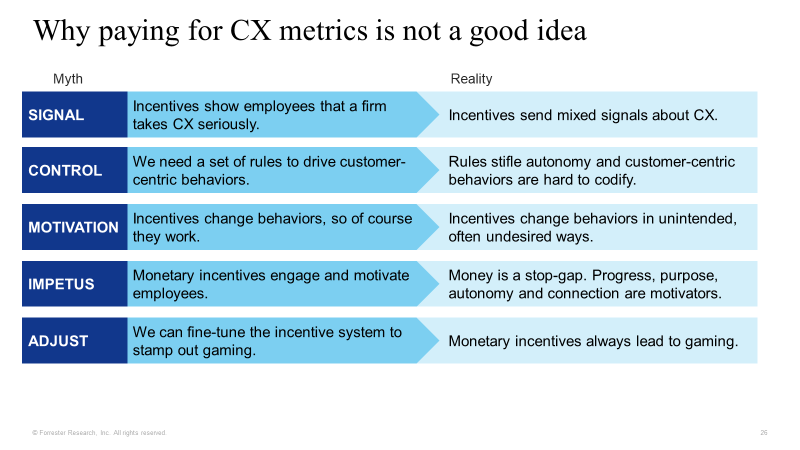Why Paying Employees For Delivering Good CX Is A Bad Idea
Tying CX performance to monetary incentives backfires. Every time. Often in spectacular, unforeseen ways. And while we have seen some firms take the leap into a world without monetary CX incentives, tying accountability for CX to money is still a common shortcut in CX transformations.
Unfortunately, that weakens employee morale and creates bad CX. In effect, to quote J. R. R. Tolkien — for the The Lord of the Rings fans among you — “short cuts make long delays.”
Five Myths Are At The Heart Of Why Firms Continue To Reach For Monetary Incentives
That’s true, even though these monetary incentives always lead to unintended consequences. Chances are your firm subscribes to one or more — hopefully not all five! — of these myths. In our latest research report, my colleague Sam Stern and I describe the five myths we uncovered:

There Are Way Better Approaches To Motivating Your Employees To Deliver Good CX!
These approaches include relinquishing some of the control we think we need to exert so that employees work “properly” and instead defining clearly what success is, providing opportunities for deliberate practice, offering prompt praise and recognition to heighten motivation for delivering better CX, and recognizing above-and-beyond performance separately. Read more in our research report.
So How Can You Help Wean Your Firm Off Of Monetary CX Incentives?
Sam and I lay out four steps that firms should take to back away from monetary CX incentives that reduce the likelihood of withdrawal symptoms. (For more details and examples, check out the full report.)
- Assess how much you spend on your current incentives. We provide a calculator to help compile the numbers and an estimate to compare against. The headline? Monetary CX incentives are expensive! That makes them an even bigger, juicier target to cut.
- Check how well that money is spent. Are your incentives prompt, exciting, peer-to-peer, unexpected, and pro social?
- Suggest alternative ways to spend the incentive budget. We strongly recommend that you reinvest it in other initiatives that will benefit employees. That could be pro-social incentives, funding donations to charities that employees can direct, or training or recognition programs that benefit employees.
- Withdraw incentives step by step. Don’t make employees go cold turkey.
Check Out The Example Of A Large UK Grocery Chain
The firm offered monetary CX incentives to their store employees based on the store’s customer survey results but saw that the process led to bad outcomes. For example, some stores posted signs that primed customers with key words from the survey questions, such as “excellent” or “welcome.” And survey response rates and scores consistently went up near the end of reporting periods, which was likely a sign of employees focusing on the survey and less on the service interaction when the deadline for calculating the monetary CX incentive loomed.
The company started its retreat from CX monetary incentives by removing the visibility to the scores — employees could see comments from surveys, but not scores. At first, store employees would try to guess the NPS results based on the comments, but that dropped off after a while, and employees became less score-obsessed. Next, the grocer disconnected employee bonuses from their store-specific CX scores, meaning that the monetary compensation the employees on the shop floor received was not directly connected to their store’s CX results but based on the countrywide brand perception. And each store received targets for incremental improvement, with the focus more on how the stores got their results, as opposed to what the results were.
So don’t create the employee-hostile culture that Barry Schwartz, psychologist and author of Why We Work, describes: “Ninety percent of adults spend half their waking lives doing things they would rather not be doing at places they would rather not be.”
